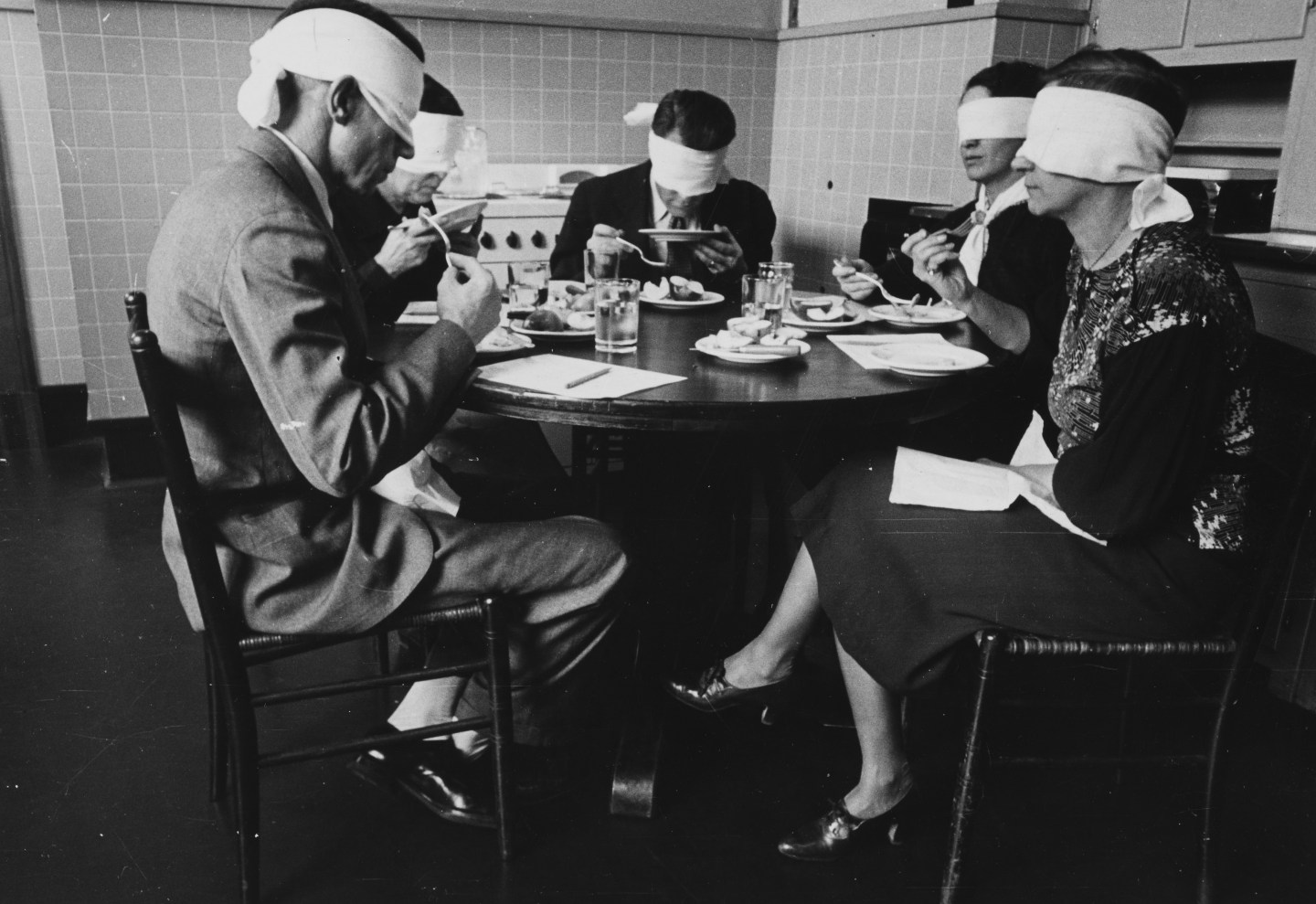Everyone in the Whole Foods conference room was sniffing a small plastic cup filled with a mysterious clear liquid, holding it to their nose as if it were a glass of fine wine.
“Sweet,” one person said.
“Salt,” decided the person next to her.
“Brown fruit,” the next dialed down.
As they continued around the room, people called out caramelized sugar, butterscotch, agave, umami, and molasses, addressing a woman at a whiteboard who looked like a Very Important Grandma in a black pantsuit with green lapels and giant pearl earrings. Her name was Myrna Fossum, and she trained companies in sensory evaluation.
Three years ago, Whole Foods (WFM) hired Fossum’s firm to put together a tasting program to maintain a high level of quality and consistency in its private-label products. Because those products are food, as Fossum says, “there’s no other way to evaluate it besides the human mouth.”
The panel meets in full once a month to train their palates, and Fossum drops in several times per year for a master training session. Meanwhile, members of the panel meet almost daily to evaluate private-label products and pass on their evaluations to buyers, who make the final call.
On this day, after Fossum finished recording the tasters’ observations, she called out what was for her a rookie mistake. “Agave?” She asked. “You’re crazy. There’s no agave in there.”
She told the tasters that they needed to look at the references again: In other words, to taste through honey, agave, butterscotch, caramelized sugar, and molasses to figure out the differences so they could be 100% accurate. All of that for a little sweet-salty drink? Indeed. Taste is infinitely complex, and Fossum’s Whole Foods tasting panel is intense.
Then Fossum revealed what she had found herself. Sweet, salt, and organic sugar, which has a caramelized note. She wasn’t far off: It turned out the liquid was organic sugar with salt added at a ratio of 2-to-1.
This type of evaluation is called sensory analysis, a small but profitable niche developed by Arthur D. Little in the 1950s and now dominated by Fossum and a company called Spectrum Sensory. The top companies in every field—food, cosmetics, home care, pharmaceuticals, pet care—use some sort of sensory program to evaluate their products. When a company wants to introduce a new product or replace one with something else, the products are evaluated using a common language of clearly defined descriptors.
Most companies with such involved panels are specialized: chocolate companies like Mars and Godiva, for example. Whole Foods is the only grocery chain to invest in a program like this at such an intense level, Fossum says.
To form the panel, Fossum gathered interested employees and trained them from the ground up. They started by tasting basics like types of sugars and grains and then worked their way up to complex foods like cola and barbecue sauce. The employees take time away from their regular jobs to sit on the panel and taste food and drinks.
On a given day, panel members might blind-taste Whole Foods’ tomato juice against a competitor’s, a fresh bottle against one that’s two months old, or its product against itself, to test their palates.
A program like this is a huge endeavor. “It takes well over a million dollars to build a simple testing facility, hire sensory professionals and consultants just to get a basic program off the ground,” said Bob Baron, the vice president of business development at Spectrum Sensory. In this case, “basic” means focusing simply on quality evaluations: How different is our product from the national brand? Does this month’s package of cookies from the factory taste the same as last month’s?
Whole Foods’ program is a much more intense variety, something called “descriptive analysis” in the industry. Normally a program like the grocery chain’s would demand an investment of more than $10 million in facilities and people, plus continued investment each year for testing and resources, Baron estimates.
But Whole Foods has been tactical about it, tapping existing employees and hiring one extremely knowledgeable outside consultant, which means it spends just a fraction of the cost, or around $1 million in Baron’s estimation (Whole Foods wouldn’t reveal the amount.)
Still, that’s a huge investment to guarantee your chocolate sandwich cookie (not an Oreo, mind you) tastes the same every time. Ugly vegetables may have made their way to grocery store shelves, but Americans still expect an unnatural level of consistency from their foodstuffs. Variation is an abomination, not something that adds character. That’s created an industry that analyzes taste not to enjoy it but to pick it apart and sell it. After all, the buyer makes the final decision about which products to stock.
That’s why, in sensory testing, there’s one rule that can’t be broken: you’re not allowed to have an offhand opinion. Everything is evaluated objectively, with a common language designed to eliminate bias.
Of course, that doesn’t mean the tasters are machines.
After Fossum’s panel put away the organic sugar mixed with salt, the panel went on to barbecue sauce. The first one was smoky, sweet. Then they sampled a second one. Pure liquid smoke, with a distinct sour note. Fossum instinctively made a face of disgust and quickly tried to hide it behind her hand.
“The problem is,” she said, “sometimes we’re human beings.”
